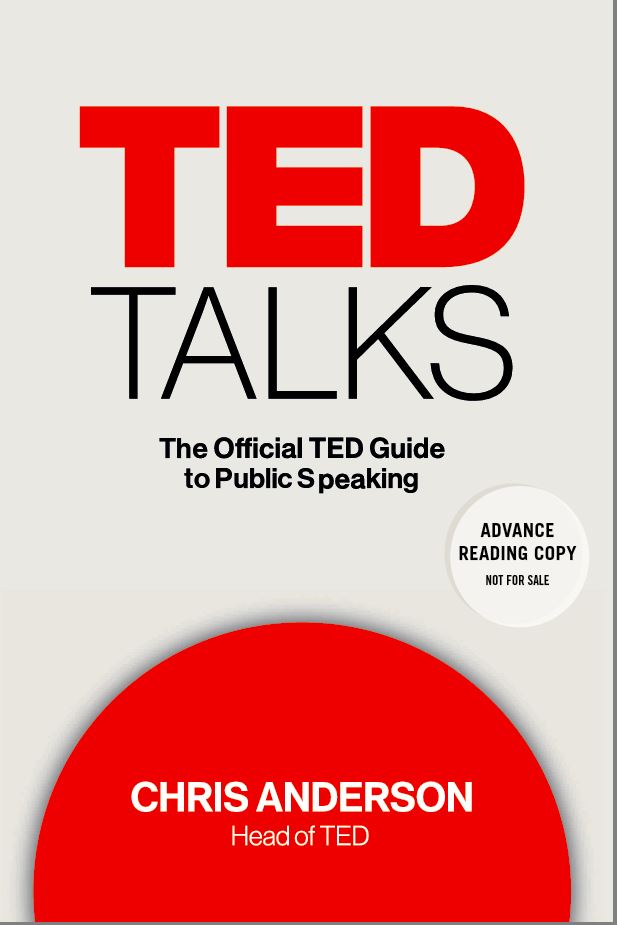In 2013, I gave a TEDx Talk. The good news is that it has over 50,000 views, which is unusually high for a TEDx video. The bad news is that there are a few things I would have changed if I had been able to read Chris Anderson's new TED Talks book. It is "The Official TED Guide to Public Speaking." I received a free advance reading copy to review.

Let's review some of the key points that Anderson makes. It begins with the obvious: “The point of a talk is to say something meaningful.”
Anderson introduces the concept of a throughline, which is "a connecting theme that ties together each narrative element. Every talk should have one." You should be able to summarize a throughline in less than 15 words and it's ideal that it has some bit of unexpectedness in them. Some examples:
- More choice actually makes us less happy.
- With body language, you can fake it till you become it.
- Terrible city flags can reveal surprising design secrets.
Questions you should ask yourself:
- Is this a topic I'm passionate about?
- Does it inspire curiosity?
- Will it make a difference to the audience to have their knowledge?
- Is my talk a gift or an ask?
- Is the info fresh or is already out there?
- Can I truly explain the topic in the time allotted, complete with examples?
- Do I know enough about this to make a talk worth the audience's time?
- Do I have credibility on this topic?
- Can I say 15 words that will persuade someone to hear my talk?
The 5 tools that speaker use are:
- Connection
- Narration
- Explanation
- Persuasion
- Revelation
Anderson encourages to use humor and offers these tips:
- Use things occurring around you and then exaggerate or remix them.
- Have a fun remark ready if you flub your words, the A/V goes awry, or if the clicker fails.
- Build humor into your visuals: contrast what you're saying with what you're showing.
- Use satire: saying the opposite of what you mean.
- Timing is critical.
He concludes, "When you can pull together humor, self-deprecation, and insight into a single story, you have yourself a winning start."
Emphasize four key things when sharing a story:
- Base it on a character your audience can emphasize with.
- Build tension
- Offer the right level of detail.
- End with a satisfying resolution.
Explaining complex subjects is tricky, but he offers one speaker as mastering this challenge:
- He started right where we were.
- He lit a fire called curiosity.
- He brought in concepts one by one.
- He used metaphors.
- He used examples.
There are lots of tools you can use here, in addition to the intuition pumps or the detective story approach:
- Inject some early humor.
- Add an anecdote
- Offer vivid examples
- Recruit third-party validation
- Use powerful visuals
"Persuasion is the act of replacing someone's worldview with something better. . . . Use the power of reason along with intuition pumps, detective stories, visuals and other plausibility-priming devices."
Here's what to ask your audience during and after rehearsals
- Did I get your attention from the get-go?
- Was I making eye contact?
- Did the talk succeed in building a new idea for you?
- Was each step of the journey satisfying?
- Were there enough examples to make everything clear?
- How was my tone of voice? Did it sound conversational or preachy?
- Was there enough variety of tone and pacing?
- Did I sound as if I was reciting the talk?
- Were the attempts at humor natural or awkward? Was there enough humor?
- How were the visuals? Did they help or get in the way?
- Were my body gestures natural?
- Did I finish on time?
- Were there moments you got a little bored? Was there something I could cut?
- Did you notice any annoying traits? Was I clicking my tongue? Swallowing too often? Shifting side to side? Repeatedly using a phrase like "you know" or "like"?
He sums up rehearsal
- Rehearse many times, preferably in front of people you trust.
- Work on it until it's comfortably under your allocated time and insist on honest feedback
- Your goal is to end up with a talk whose structure is second nature to you so that you can concentrate on meaning what you say.
Four ways to get attention
- Deliver a dose of drama
- Ignite curiosity
- Show a compelling slide, video, or object.
- Tease, but don't give away.
Seven ways to end a talk
- Camera pull-back
- Call to action
- Personal commitment
- Values and vision
- Satisfying encapsulation
- Narrative symmetry
- Lyrical inspiration
Verdict
I give it 9 out of 10 stars. The 300-page book is useful for any public speaker.
Carmine Gallo's Talk Like TED book is slightly better for giving practical speaking tips than Anderson's book. However, an official guide from the TED Curator is worth reading if you're serious about delivering a TED talk one day (or you're a professional speaker). The wisest thing to do is get both books.
After you read the book, you can see the errors that I make in my TEDx talk (see below). My dream is to present at the main TED conference to share my ideas on Africa after my trip to all 54 African countries.
Talk Like TED



